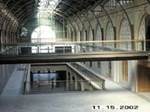Electric ferry runs quietly with composites
Infused sandwich construction hull and superstructure panels offset battery system weight.
For marine transportation operators driven by ever-tighter environmental regulations, emissions and nuisance noise reduction have joined increasing efficiency as top priorities. One means for meeting them all is electric propulsion. A case in point is Stockholm, Sweden’s SL public transportation system and its ferry operator Ballerina, which recently introduced its first battery-powered ferry boat. Featuring a high-tech marine lithium-ion (Li-ion) battery system from Saft Group (Paris, France) the M/S Sjövägen makes 10 stops on a 50-minute route through the Stockholm waterways all year, completing eight round trips per day. Designed and manufactured by boatbuilder Faaborg Vaerft (Faaborg, Denmark) with engineering firm Principia North A/S (Svendborg, Denmark) and marine fire-suppression expert Wilhelmsen Technical Solutions (Lysaker, Norway), the ferry’s composites were a must for the majority of the vessel, to offset the weight of the battery packs.
The ferry’s hull and superstructure feature fiberglass-faced sandwich construction cored with Divinycell H polyurethane/polyvinyl chloride foam, a high-strength closed-cell product with good fatigue resistance and low water uptake, made by Diab International AB (Laholm, Sweden). “We used the sandwich composite panels mainly for the hull, topsides and wheelhouse,” says Jan Ulrich Mortensen, managing director at Faaborg Vaerft. Christian Karlsson, DIAB’s sales/marketing manager for Europe and Asia, says the hull sandwich was layed up in a one-piece mold and infused. The superstructure components were assembled from infused flat panels. “It is a great solution,” sums up Mortensen, “due to its strength, noise reduction and vibration-damping properties.”
Related Content
-
Plant tour: Airbus, Illescas, Spain
Airbus’ Illescas facility, featuring highly automated composites processes for the A350 lower wing cover and one-piece Section 19 fuselage barrels, works toward production ramp-ups and next-generation aircraft.
-
Reinforcing hollow, 3D printed parts with continuous fiber composites
Spanish startup Reinforce3D’s continuous fiber injection process (CFIP) involves injection of fibers and liquid resin into hollow parts made from any material. Potential applications include sporting goods, aerospace and automotive components, and more.
-
Active core molding: A new way to make composite parts
Koridion expandable material is combined with induction-heated molds to make high-quality, complex-shaped parts in minutes with 40% less material and 90% less energy, unlocking new possibilities in design and production.



